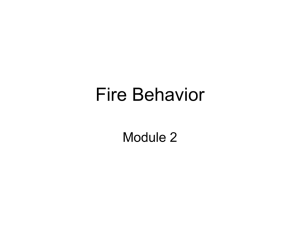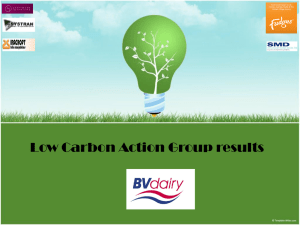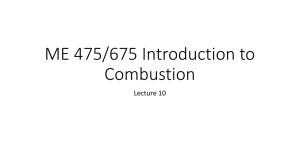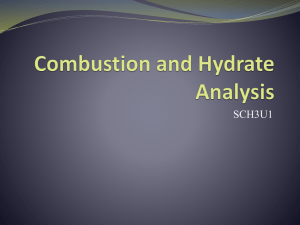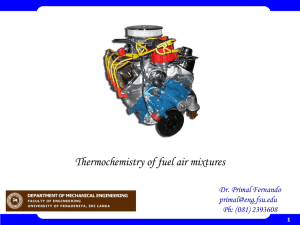Carbon monoxide
advertisement
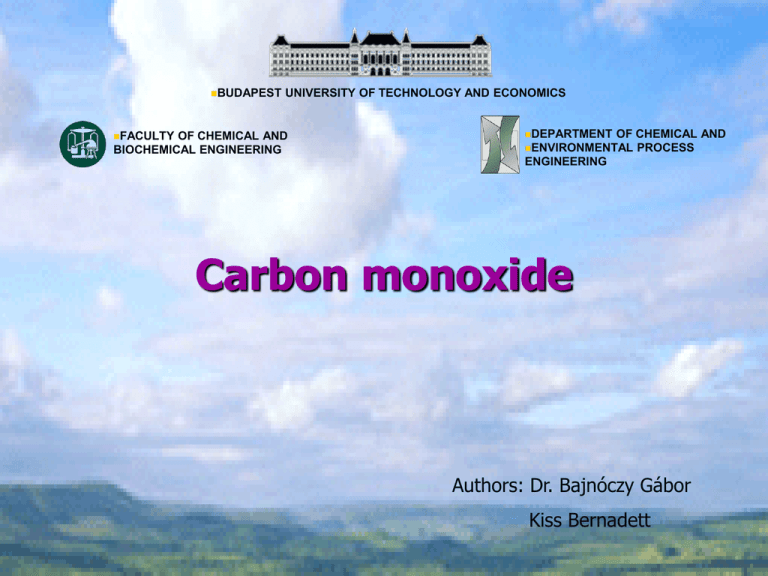
BUDAPEST FACULTY UNIVERSITY OF TECHNOLOGY AND ECONOMICS OF CHEMICAL AND BIOCHEMICAL ENGINEERING DEPARTMENT OF CHEMICAL AND PROCESS ENVIRONMENTAL ENGINEERING Carbon monoxide Authors: Dr. Bajnóczy Gábor Kiss Bernadett The pictures and drawings of this presentation can be used only for education ! Any commercial use is prohibited ! Carbon monoxide Some physical properties of CO •colorless •odorless 28.01 Moolecular mass Melting point -199 oC Boiling point -191.5 oC •tasteless •Burns with blue flame density Most abundant and widely distributed pollutant in the lower atmosphere Solubility in water* It has a density 96.5% that of air Reversible effect in small concentration 0 0C, 101.3 kPa 25 0C, 101.3 kPa 0C 0 20 0C 25 0C Low and high flamability limits Conversion factors 0 0C, 101.3 kPa 25 0C, 101.3 kPa * volume of CO in STP mass/mass *** volume/volume ** 1.250 g/dm3 1.145 g/dm3 low 3.54 cm3/100 cm3 (44.3 ppmm)** 2.32 cm3/100 cm3 (29.0 ppmm)** 2.14 cm3/100 cm3 (26.8 ppmm)** Wide range 12,5 – 74,2 tf % 1 mg/m3 = 0.800 ppmv*** 1 ppm = 1.250 mg/m3 1 mg/m3 = 0.800 ppmv*** 1 ppm = 1.250 mg/m3 Sources of carbon monoxide Natural <=> Antropogenic ( 10-50% of the total) Differences: Distribution: 1. Natural sources: distributed throughout the world 2. Anthropogenic sources: concentrated in small area Rates of formation: 1. Natural conditions: rate of formation ≈ rate of elimination 1. In the vicinity of antropogenic sources (towns, industrial areas): rate of formation > rate of elimination (accumulation) Natural sources of carbon monoxide Indirect sources: mud, bogs ►anaerob conditions ►methane formation from the decay of organic materials The surface of oceans is supersaturated in carbon monoxide: Algae and other biological sources. Decay of chlorophyll in the soil Sources of natural carbon monoxide Mud, oceans, chlorophyll… The majority of CO is indirect origin: oxidation of methan ► CO! organic materials Anaerob conditions Biological decay methane OH * CO Formation CO from methane 1. 2. 3. 4. 5. 6. CH4 + •OH = •CH3 + H2O •CH3 + O2 + M = •CH3O2 + M * Strong oxidation character •CH3O2 + NO = •CH3O + NO2 Lifetime: some hours •CH3O + O2 = HCHO + •HO2 4-6 ppbv λ<338nm HCHO •H + •HCO •HCO + O2 = CO + •HO2 HCHO + •OH = CO + •HO2 + H2O Reactions of the other formed radicals •H + O2 + M = •HO2 + M * •HO2 + NO = •OH + NO2 CO from anthropogenic sources 1. 2. 3. 4. Transportation: Internal combustion engines (~75%) Agricultural burning: (~ 10%) Industrial process losses: Steal industry, carbon black production, petroleum refineries (~ 10%) Fuel combustion – stationary sources: coal, fuel oil, natural gas, wood (~ 1%) Low CO → greater efficiency Chemistry of the CO formation The formation of anthropogenic CO is generally the result of the following chemical processes: 1. Incomplete combustion of carbon or carbon containing compounds 2. High temperature reaction of glowing carbon and carbon dioxide 3. Dissociation of carbon dioxide at high temperature Incomplete combustion of carbon or carbon containing compounds ORIGIN OF THE RADICALS IN THE FLAME H2O → H + OH* O2 → 2 O CxHy → CxHy-1 + H O + H2O → 2 OH* thermal decay thermal decay thermal destruction Stops under 650 °C 650ºC alatt leáll Incomplete combustion of carbon or carbon containing compounds Fuel and air are poorly mixed Localized areas of oxygen deficiency Accumulation of CO Optimized combustion conditions: air excess ratio (n) = Actual input of air ▬▬▬▬▬▬▬▬▬▬▬▬▬▬▬▬▬▬▬▬▬ Theoretical need of air input for the perfect combustion Incomplete combustion of carbon or carbon containing compounds • n = 1 : In case of perfect mixing the available lowest CO content • n < 1 : the amount of oxygen is not enough for the CO → CO2 transformation • n > 1 : too much air cools down the combustion chamber and residence time is decreasing. There is not enough time for the slow CO → CO2 reaction. Reaction of glowing carbon with carbon dioxide CO2 + C = 2 CO Reduction of iron ore: reduction CO + iron oxide iron a part of it escapes into the atmosphere Coal in the fire box: Air input is limited suddenly CO accumulation CO concentration is above the low flamability limit CO & air is exploded from the glowing carbon Dissociation of carbon dioxide In spite of the perfect burning conditions carbon monoxide is present because of the dissociation of carbon dioxide: CO2 <=> CO + O The temperature increase shifts the equilibrium towards the CO Eg. 1745 ºC 1% , 1940 ºC 5 % The quick cooling of the hot gases results in untransformed CO. (There is no time to be transformed. At low temperature the rate of the reaction is very slow, can be neglected.) The fate of atmospheric CO The CO concentration should be doubled within 4-5 years The CO concentration is nearly constant in the troposphere ► effective elimination reaction must exist. A hydroxyl radicals ~ 40% CO is oxidized CO + OH• → CO2 + H• The fate of atmospheric CO Condition: nm O*+ O2* O3 310 O* + H2O = 2 ∙OH CO + • OH = CO2 + H CO uptake by the soil Different microscopic fungi CO → CO2 CO uptake 0 – 100 mg CO/(hour m2 ) The rate of uptake depends on the organic content of the soil. The CO uptake by the soil types I. ~ 0 mg CO/m2hour ~ 100mg CO/m2hour The CO uptake by the soil types II. CO uptake is low significant CO uptake The CO uptake is restricted in the town. The soil is covered or severely polluted Effects of CO on plants No detrimental effects have been detected. Urban air : 50-60 ppm → no problem Effects of CO on Humans The oxygen uptake is restricted Hemoglobin (Hb): O2 and CO2 transport. CO2Hb in the lung, CO2 is exchanged to O2, O2Hb in the tissue, O2 is exchanged to CO2 CO2Hb + O2 O2Hb + CO2 In COHb the bond is 250 times stronger Effects of CO on Humans The COHb content of the blood depends on the CO concentration of the air, the physical activity and the residence time in the polluted area. Control of CO pollution Transportation is mainly responsible Solutions: Perfect mixing of air and fuel. The maximum has been reached. Slow cooling of the exhaust gases. It is not possible Quick oxidation to CO2: catalytic transformation of carbon monoxide to carbon dioxide Combustion of coal, oil, gas and biomass: The emission is restricted officially. Emission limits for different fuels in Hungary [mg/Nm3] Output range 140 kW-50 MW regulation number: 23/2001 KöM Carbon monoxide Solid fuel Liquid fuel Gas fuel 250 175 100 Control of CO emission Combustion devices, the CO depends on: Particle size of the fuel (greater the size, higher the CO emission) Structure of the solid fuel (airy, loose structure eg. straw, local oxygen deficiency in the bulk) Mixing of air and fuel (perfect mixing results in low CO emission) Air excess ratio (lack of oxygen or low temperature and residence time) Residence time at high temperature (longer residence time at high temperature decreases the CO emission) Control of CO emission: boilers Thermal afterburner Min. temp: 850 °C heat exchanger Min. residence time: 2 sec preheated flue gas flue gas with high CO content gas burner afterburner Control of CO pollution: transportation Will be discussed later. ( See: hydrocarbons)


